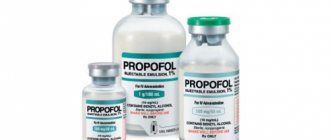This is an acute pathology of the eye, in which complete or partial separation of the neuroretina from the pigment epithelium of the retina and choroid (choroid) occurs. Normally, these structures fit tightly together, providing nutritional functions.
When the retina of the eye is detached in animals, vision decreases until complete blindness.
(dilated pupils in the daytime, blurred vision), and in advanced cases leads to the death of the eye. Therefore, this pathology is an emergency condition and requires immediate contact with a veterinary ophthalmologist.
Retinal detachment in a dog. Ophthalmoscopy view.
Causes
This eye disease occurs in both dogs and cats, but often has different causes. For example, for cats, it is most typical with both total and local retinal detachment of an exudative nature. The most common factors and pathologies that can lead to retinal detachment in dogs and cats are: 1. Congenital malformations such as retinal dysplasia (RD), collie eye anomaly (CEA), and primary hyperplastic persistent vitreous (PHTVL/PHPV) syndrome. , 2. Trauma to the eye, leading to retinal rupture and hemorrhage, 3. Inflammatory processes), leading to accumulation of exudate or blood in the subretinal space, 4. Degeneration and dysplasia of the vitreous body, 5. Neoplasms of the posterior segment of the eye, including the choroid, 6. Buphthalmos, leading to stretching of the membranes of the eyeball, 7. Pathologies leading to damage to the vascular bed: blood hyperviscosity syndrome, diabetes mellitus. It should be noted that retinal detachment is a condition that requires an emergency visit by the animal owner to a veterinarian and immediate assistance to the patient. In many cases, when treatment is timely, and depending on the type and cause of detachment, the prognosis for vision can be favorable. However, the lack of treatment, the inability to diagnose this pathology, as well as late treatment can lead to complications that can arise after retinal detachment - hemophthalmos, etc. In such cases, irreversible blindness develops and a high risk of losing the eye as an organ.
Clinical signs
Symptoms of retinal detachment in dogs and cats include partial or complete loss of vision (acute blindness), decreased or absent pupillary light response (PLR), retinal floaters and blood vessels visible without special equipment on a dilated pupil. Often, retinal detachment can be accompanied by hemophthalmos (accumulation of blood in the vitreous body). As already mentioned, retinal detachment in many cases can be a concomitant symptom of the underlying disease. Therefore, it is important to take this connection into account, even in the absence of obvious signs of detachment.
Retinal detachment in a cat due to systemic arterial hypertension
Diagnostics
Confirmation of the diagnosis of retinal detachment is made based on a medical history, examination by a veterinary ophthalmologist and diagnostic tests. Animal owners, in most cases, complain of dilated pupils and blindness of varying degrees. In cats, fibrin and blood may be present in the intraocular space. To make an accurate diagnosis, it is recommended to use a comprehensive diagnostic approach: an ophthalmological examination ( biomicroscopy, ophthalmoscopy, ultrasound
), as well as assessment of the animal’s somatic condition (clinical and biochemical blood tests, examination for the presence of infections, cardiac examination, etc.)
Retinal detachment in a dog. Ultrasound image.
Ultrasound of the eye is the gold standard for diagnosis in animals with suspected retinal detachment. It is especially important that this study is relevant when it is impossible to perform ophthalmoscopy and when the optical media of the eye are opaque (hyphema, hemophthalmos, corneal edema). With an ultrasound of the eyeball, it is possible to assess the degree and type of detachment, the presence of exudate, blood, concomitant pathologies of the vitreous body (moorings, destruction) and choroid.
Treatment
Since retinal detachment is an acute condition leading to decreased vision and blindness, the speed of treatment and the urgency of the assistance provided play a decisive role in the further prognosis of the disease. A long-term lack of medical care, as a rule, leads to disruption of the retina. This is due to the lack of contact between the detached retina and the choroid (choroid), and a violation of trophism and metabolism between them. However, with emergency care for a patient with a detachment, it is possible to restore vision, both with the help of conservative treatment and surgery.
When the retina of the eye is detached in dogs, cats and other animals, vision decreases to the point of complete blindness (dilated pupils during the day, blurred vision), and in advanced cases leads to the death of the eye. Therefore, this pathology is an emergency condition and requires immediate contact with a veterinary ophthalmologist. Below is the work of our specialist on this topic.
Komarov Sergey Vitalievich, Ph.D. MGAVMiB im. K.I. Scriabin, bmdg.ru Center for Emergency Veterinary Ophthalmology and Microsurgery, website Veterinary ophthalmologist, microsurgeon, Moscow.
Introduction
Retinal detachment in cats and dogs is a serious emergency condition in which the neuroretina (NR) separates from the pigment epithelium (RPE). This leads to disruption of the interaction of these layers, which results in visual impairment. The main method of treatment is surgical. The principle of treatment is to bring the neuroretina closer to the PE and localize the rupture with foci of chorioretinal inflammation. A long-term state of OS causes irreversible changes and death of neurons. This always leads to decreased vision.
Drugs of choice in the treatment of uveitis
Glucocorticoids:
- Prednisolone acetate 1% suspension every 1-12 hours
- Dexamethasone solution 0.1%, 0.05% ointment every 1-12 hours
- The frequency depends on the severity of the inflammation.
- Reduce use once inflammation resolves.
Subconctival injections:
- Methyl prednisolone acetate
- Betamethasone
- Triamcinolone (rarely used for anterior uvetitis). Use a single injection in severe cases followed by topical application. Do not use in cats with suspected herpesvirus type 1 infection.
Systemic medications Prednisolone tablets orally every 12-24 hours. Only if systemic infection is excluded.
Nonsteroidal anti-inflammatory drugs
Local solutions
- Diclofenac 0.1% every 6 -12 hours
- Ibuprofen 0.03% every 6-12 hours
- Suprofen 1% every 6 -12 hours
- Ketarolac 0.5% every 6-12 hours
- Frequency depends on severity of inflammation
Systemic drugs
- Aspirin can be increased to a single dose every 12 hours, but the interval between doses will increase to 48-72 hours.
- Meloxicam
- Kaprofen
- Ketoprofen every 24 hours
- Karpofen
- Deracoxib
Local mydriatics/cycloplegics (paralyzing accommodation)
- Atropine sulfate 1% solution and ointment every 8-24 hours Pupil dilation for the prevention of posterior synechiae. Reducing spasm of the ciliary muscle to reduce pain intensity. The frequency of administration depends on the severity of the inflammation. A reasonable technique is required to achieve the desired result.
Structure
The retina includes 10 layers, all of them extend deep into the eyeball.
- 1. pigment epithelium;
- 2. photosensory;
- 3. external limiting membrane
- 4. external granular;
- 5. outer mesh;
- 6. internal granular;
- 7. inner mesh;
- 8. layer of ganglion cells;
- 9. nerve fibers;
- 10. internal limiting membrane.
The retina contains neurons located in 3 levels: - Level of light-sensitive neurons – external
- The level of local associative neurons, which connect neurons with each other
- The level of ganglion neurons, their axons go to the optic disc and form the optic nerve
The RPE is a monolayer of neuroepithelium and performs very important functions: - — The barrier between the choroid (CO) and the HP ensures the functioning of the blood-retinal barrier;
- — HP adhesion;
- — Provides accumulation, isomerization and supply of vitamin A to photoreceptors to restore visual pigments;
- — Provides active selective transport of metabolites between the retina and uveal tract;
- — Carries out the synthesis of glycosaminoglycans surrounding the outer segments of photoreceptors;
- — Promotes the formation of photoreceptors in embryogenesis;
- — Maintains the constancy of the environment between the pigment epithelium and photoreceptors, maintains the structure of contact between the outer segments of rods and cones, and the RPE’s own cells;
- — Absorbs light energy by melanin granules, improving vision clarity. Some animal species have a reflective plate, improving vision in low light conditions.
Symptoms
The clinical picture largely depends on the location of the inflammation. However, general symptoms of ocular uveitis in cats can be identified:
- redness of the sclera;
- frequent production of tears;
- soreness in the eyes;
- fear of bright light;
- swelling of the eyelids;
- the appearance of blood clots in the organ of vision;
- narrowing and changing the shape of the pupils;
- lack of pupillary response to light stimuli;
- lethargy, apathy, signs of general malaise.
With anterior uveitis, you may notice a pink halo around the iris. The animal's vision deteriorates, and exudate accumulates on the eyeballs. The pupil stops responding to light. The cat constantly squints and shakes its head due to photophobia and pain in the eyes. Often the color of the iris of the affected eye changes in a pet. Light colored patches can be seen on the cornea.
With posterior uveitis, visual impairment is often observed. Diagnosing this form of the disease on your own is quite difficult. Choroiditis and chorioretinitis can only be diagnosed by a veterinary ophthalmologist. Sick cats experience swelling and redness of the fundus, as well as changes in the shape of the iris.
With panuveitis, signs of damage to the iris and retina are combined with symptoms of inflammation of the choroid. This form of pathology has the most unfavorable prognosis.
Types of disease
According to the mechanism of formation, four types are distinguished:
What is uveitis
Uveitis in cats is a group of diseases that are characterized by inflammation of the vascular tract of the eye. In this case, the eyeball is affected and the nutrition of the organ of vision deteriorates.
The vascular system of the eye (uveal tract) consists of the following elements:
- irises;
- ciliary body;
- choroid (choroid).
The inflammatory process can develop in any part of the uveal tract. In some cases, damage to all structures of the vascular system is observed.
This disease can lead to serious consequences. In advanced cases, it can result in blindness. Every pet owner needs to know about the symptoms and treatment of ocular uveitis in cats in order to pay attention to dangerous signs of pathology in time.
Reasons for development
Rhegmatogenous OS
– with a rupture of the retinal plane.
Types of breaks:
Traction OS
The presence of vitreoretinal adhesions (proliferative vitreoretinopathy) Can develop with proliferative diabetic retinopathy, hemorrhage, thrombosis of the retinal veins, etc. Membranes are formed by PE cells; Deformation and tension of the retina due to the formation of fibrous tissue leads to elevation of the neurosensory retina above the underlying pigment layer - OS.
Exudative OS
Occurs when the integrity of the vascular wall is violated, which causes plasma to escape into the subretinal space (hypertension, central vein thrombosis, vasculitis, optic disc edema, infusion therapy errors)
Often without rupture, total bladder-like OS, sometimes with subretinal hemorrhages
Additionally
Contraindications Topical and subconjunctival glucocorticoids are contraindicated for corneal ulcers. Methylprednisolone acetate can lead to subconjunctival inflammation, resulting in additional discomfort. Topical application of atropine can significantly reduce tear production, resulting in dry eye. Long-term use of topical atropine may lead to the development of secondary glaucoma. The use of non-steroidal anti-inflammatory drugs in cats is dangerous due to severe side effects. Avoid drugs that constrict the pupil (pilocarpine, latanoprost, etc.)
Information for owners
The use of topical glucocorticoids is contraindicated in the development of corneal ulcers. Prevent self-injury with a special collar if necessary. Repeated examination is often necessary for moderate to severe inflammation. Further training depending on the primary cause.
Patient monitoring
Repeat examinations every 1-7 days depending on severity and response to treatment. Monitor intraocular pressure, as it may increase with decreased inflammation. If it increases with stable or worsening inflammation, this indicates obstruction of the outflow of intraocular fluid and the development of glaucoma.
Endovitreal intervention
Cataract, glaucoma, retinal detachment
All these diseases are quite common in dogs, especially older ones. Cataract is accompanied by clouding of the lens; externally, the disease is expressed in clouding of the eye, which acquires a matte gray-bluish, light gray or milky gray color. There are no discharge or other symptoms of conjunctivitis and keratitis.
In addition to old age, the cause of cataract formation can be diabetes, toxicosis and trauma. Treatment boils down to instillation of vita-iodurol-triphosadadenine, viceine and vitamin preparations into the eye, 1-2 drops 2-3 times a day. Therapy is long-term and only slows down the development of the disease.
Cataract
Surgeries on the lens for cataracts in dogs are possible, but are rarely used in practice.
Glaucoma is characterized by a constant or periodic increase in intraocular pressure from 30 (normal) to 70 mm Hg. Art. The most common type of glaucoma in dogs is secondary (in addition to this type of disease, congenital and primary glaucoma is also found). The causes of the disease are quite varied: deep keratitis, displacement or swelling of the lens, hemorrhages in the vitreous body and anterior chamber of the eye, as well as contusions of the eye and penetrating wounds from trauma.
The disease is expressed by clouding of the lens, atrophy of the iris, and sometimes changes in the shape of the pupils. The dog's eyes are cloudy, gray-blue in color; when palpated, the eyeball is compacted and enlarged in size. When treating glaucoma, the drug method is primarily used, and only if this does not give visible results, surgery is used. Increased intraocular pressure in dogs can be cured by instilling a 1% solution of pilocarpine 5-6 times a day, as well as GLP with the same drug once a day. A solution of phosphakol at a concentration of 0.02% is also used 2-3 times a day.
Treatment of glaucoma should be started in a timely manner to avoid complications, the most dangerous of which is hemorrhages in the space between the choroid and the retina and, as a consequence, its detachment.
In addition to complications with glaucoma, retinal detachment can be caused by trauma, atrophy of the vitreous, or large accumulation of exudate in the chambers of the eye. With this disease, the animal’s vision suddenly deteriorates greatly, up to the onset of blindness, the pupils dilate, and there is no reaction to light with a rapid change in its intensity. The final diagnosis is made by a veterinarian when examining the dog's fundus.
With a complete retinal detachment, it is not possible to cure a dog: the dog becomes completely blind.
Partial detachment can be treated with subconjunctival injections of 0.1-0.2 ml of hydrocortisone with novocaine every 3-4 days. At the same time, 0.3-0.5 ml of dexazone is administered daily. Atropine at a concentration of 1% or 2% dionine solution is instilled into the conjunctival sac. This text is an introductory fragment.
From the author's book
Cataract This disease is characterized by clouding of the lens. In some cases, cataracts are clearly visible to the naked eye as whitish lumps that give the lens a milky-gray or bluish-white mottled appearance behind the pupil. Cataracts are observed in any
From the author's book
Cataract Cataract is clouding of the lens. Some scientists consider it a widespread eye disease in dogs, mostly older than eight years of age. Typically, cataracts are easily visible to the naked eye as a white, cloudy spot in the
From the author's book
Cataracts, glaucoma, retinal detachment All these diseases are quite common in dogs, especially older ones. Cataract is accompanied by clouding of the lens; externally, the disease is expressed in clouding of the eye, which acquires a dull gray-bluish color,
From the author's book
Cataracts, glaucoma, retinal detachment These diseases are quite common in dogs, especially older ones, and can deprive the pet of his vision. Cataract is accompanied by clouding of the lens; externally, the disease is expressed in clouding of the eye, which becomes dull
From the author's book
Cataracts, glaucoma, retinal detachment All these diseases are quite common in dogs, especially older ones, and can deprive the pet of vision. Cataract is accompanied by clouding of the lens; externally, the disease is expressed in clouding of the eye, which acquires
From the author's book
Cataracts Cataracts are considered the second most common eye disease in dogs. Juvenile cataracts can appear in purebred dogs at a very early age. There are two forms of this disease - absorbable and non-absorbable. In the first case
The retina is the thinnest inner layer of the eye that is sensitive to light. Retinal detachment involves the separation of the retina from the choroid. The reason for this may be either genetics or some serious illness. The disease is treatable, but we must remember that in advanced cases it can lead to complete blindness.
Symptoms and types
Dogs with a detached retina may show signs of complete or partial vision loss. The iris is often dilated and there may be no reaction to light.
Description of ophthalmological disease: uveitis in cats
One of the most common diagnosed and serious eye diseases in cats is uveitis (iritis, iridocyclitis).
Uveitis is an inflammatory process that can develop and affect various structures and segments of the choroid (uveal tract). The uveal tract is the middle layer of the eyes, consisting of the iris, ciliary (ciliary) body and choroid.
The uveal tract anatomically consists of an anterior and posterior section. The anterior part includes the iris and ciliary body, the posterior part includes only the choroid. Uveitis is diagnosed in all members of the cat family, regardless of age and breed of cat. In most cases, uveitis is not a primary, but a secondary symptom of some somatic pathology or disease.
Classification of uveitis in cats
As already noted, the pathological inflammatory process can cover various areas, structures and sections of the uveal tract, therefore, depending on the affected area of the choroid, uveitis is classified into:
- iridocyclitis
– inflammation is diagnosed in the iris and ciliary body (anterior uveitis); - iritis
- the inflammatory process affects the iris; - cyclitis
– inflammation of the ciliary (cilial) body; - choroiditis
– inflammation in various segments and areas of the choroid (posterior uveitis); - panuveitis
is an ophthalmological disease in which the pathological process completely covers the choroid, iris, ciliary body, that is, damage occurs in all structures of the uveal tract.
In addition, primary, secondary, acute, chronic uveitis, granulomatous (unilateral and bilateral), infectious, simple, non-infectious forms of uveitis are diagnosed.
Causes of uveitis in cats. Etiology
The development of this ophthalmological pathology can be facilitated by a wide variety of reasons, which can be divided into exogenous (external) and endogenous (internal) unfavorable factors.
Causes
Retinal detachment can occur in any dog, regardless of breed or age.
However, it is noted that
older animals are most often susceptible to the disease
. In some dogs, detachment occurs due to congenital defects. If retinal detachment occurs in both eyes, this may be a sign of a serious disease, such as glaucoma. A possible cause of the disease can also be exposure of your pet to toxic substances.
High blood pressure (hypertension) is considered one of the risk factors.
Other metabolic causes of retinal detachment may be
hyperthyroidism
, characterized by increased activity of the thyroid gland,
hyperproteinemia - increased protein levels in the blood,
and hypoxia, that is, reduced oxygen content in the body's tissues. In addition to these conditions, possible causes include eye trauma, ocular neoplasia (intraocular tumor), and inflammation of the blood vessels inside and outside the eye.
Diagnosis of uveitis
Differential diagnosis. What uveitis-like diseases need to be excluded or confirmed, and how to do this?
- Conjunctivitis - there is only injection of conjunctival vessels, discharge from the eyes, there are no intraocular changes associated with anterior uveitis, intraocular pressure is normal, pain is usually moderate and relieves with local anesthetics.
- Episcleritis/scleritis (inflammation of the sclera, the white of the eye) - there is an injection of the vessels of the sclera and conjunctiva, periorbital corneal edema, thickening of the sclera (possibly), intraocular pressure and the state of the anterior chamber are normal until signs of anterior uveitis develop.
- Glaucoma – there is increased intraocular pressure, the pupil is often dilated, the eyeball may be enlarged in size (buphthalmos), the cornea may have a groove.
- Any other pathology that can cause injection of scleral and conjunctival vessels (keratitis, Horner's syndrome, etc.).
Diagnosis of uveitis
- Eye examination, including fluorescent staining of the cornea and determination of intraocular pressure.
- To identify possible systemic causes of the disease - general clinical examination, general blood test, serum biochemistry, urine test. Subsequently (serology, microbiological studies, imaging studies), if necessary, are carried out based on the results of the physical examination and initial laboratory tests.
- An ultrasound examination of the eye will reveal a primary eye disease if direct examination is not possible due to clouding of the eye media.
- Examination of the intraocular fluid and vitreous humor may also be needed to make a diagnosis; intraocular fluid is used for cytology, culture studies and determining the presence of bacteria and sensitivity to antibacterial agents, polymerase chain reaction, and antibody composition.
Histopathological findings
- Corneal edema and, in chronic cases, neovascularization (sprouting of new blood vessels), corneal precipitates (clumps of white blood cells on the corneal endothelium).
- The anterior chamber of the eye contains erythrocytes, leukocytes, fibrin.
- Iris – infiltration with leukocytes (cell composition depends on the etiology); adherence of the iris to the lens (posterior synechiae); adherence of the iris to the cornea (anterior synechiae); periridal fibrovascular membranes (in chronic cases).
- Ciliary body - infiltration with leukocytes, similar to the iris.
- Lens - pigment migration on the capsule; posterior synechiae, in chronic cases, cataracts.
Treatment
Treatment is prescribed depending on the cause and severity of the disease. There are methods of retinal engraftment using surgery
, as well as methods for regenerating retinal tissue. If surgery is not necessary, then treatment will be aimed at eliminating the cause of the detachment and will be carried out with the help of medications.
During the postoperative period, try to limit your pet's physical activity. Possible complications associated with retinal detachment can cause blindness, clouding of the lens of the eye (cataract), glaucoma, and chronic eye pain. For timely diagnosis of these conditions, it is necessary to regularly show the dog to the veterinarian.
In cases where retinal grafting is not possible and the dog is at risk of complete blindness, your veterinarian will teach you the necessary skills to care for a blind animal.
Treatment of uveitis in dogs and cats
Attention!
This information is for informational purposes only and is not intended to be a comprehensive treatment for each individual case. The administration declines responsibility for failures and negative consequences during the practical use of these drugs and dosages. Remember that the animal may have individual intolerance to certain medications. Also, there are contraindications to taking medications for a particular animal and other limiting circumstances. If you use the information provided instead of the assistance of a qualified veterinarian, you do so at your own risk. We remind you that self-medication and self-diagnosis only bring harm.
Treatment goals for anterior uveitis:
- Causal therapy for the identified cause (treatment of corneal ulcer, infection, neoplasia, lens luxation, etc.).
- The general treatment for all cases of anterior uveitis is to stop inflammation, prevent and control complications caused by inflammation (eg, posterior adhesions, glaucoma), and relieve pain.
Acute catarrhal conjunctivitis
The disease usually occurs in an acute form. It is associated with inflammation of the mucous membrane of the eye.
Symptoms
When acute catarrhal conjunctivitis appears, swelling and redness appear around the eye. The cat will experience pain, which will affect its behavior. Serous-mucous discharge will begin to accumulate in the corner of the animal’s eye and lacrimation will increase.
Causes
This disease can develop as a result of mechanical trauma. If it has not healed well and dirt has gotten into it, then conjunctivitis may appear. Any infectious disease is also considered another cause. And finally, a lack of vitamin A in the body (hypovitaminosis A) very often causes such inflammation.
Giving help
For proper treatment, it is first necessary to establish the cause of acute catarrhal conjunctivitis. If damage is detected, you must immediately treat the eye with a 0.25% novocaine solution. This procedure must be repeated regularly, and a solution of 0.25% chloramphenicol should be instilled several times a day. For other causes of this disease, after washing, a 0.25% solution of chloramphenicol or a 1% solution of kanamycin should be instilled into the eye. Sofradex and a 10-30% solution of sodium sulfacyl are well suited for the same purposes. This procedure should be carried out up to 5 times a day, instilling 2-3 drops of medicine. If the disease is advanced, then in addition to this treatment it is necessary to lubricate the eyelid with antibiotic ointments several times a day or apply bandages with these ointments.
Prevention
How to prevent uveitis? Most often, this disease develops against the background of other pathologies. Veterinarians advise adhering to the following recommendations:
- Protect your cat's vision from injury and burns.
- Do not allow the animal to walk on its own. Cats most often suffer eye injuries while outdoors.
- Timely cure infectious pathologies in animals.
- Pets suffering from chronic eye diseases and autoimmune disorders should be under the supervision of a doctor.
- Regularly undergo preventive examinations with a veterinary ophthalmologist.
These measures will help prevent inflammation of the vascular tract of the eye and avoid severe visual impairment.
Sources:
https://www.prostozoo.com.ua/spravochniki/bolezni_zhivotnyh/id/976 https://house-animals.ru/bolezni-glaz-u-koshek/uveit-u-koshek-lechenie-i-simptomy https: //fb.ru/article/421458/uveit-u-koshek-prichinyi-priznaki-i-metodyi-lecheniya
Drugs used
Many argue that mydriatics are very important - drugs that reduce spasms of the ciliary muscle and also relieve pain. The use of these medications minimizes the chance of pathogenic substances entering the blood.
The use and dosage should be prescribed by the attending physician. Please note that home treatment may lead to complications. As soon as you notice something is wrong or your cat begins to complain of feeling unwell, there is no need to search for information on the Internet - immediately go to the veterinarian. It is important to follow all the necessary instructions from a professional, as they lead to a full recovery for your furry pet.
Correctly selected medicine makes it possible to prevent possible complications and the occurrence of new infections. A decrease in pain reactions, as well as an improvement in the cat’s general condition, indicates that he is recovering, and medications only have the best effect on your animal.
Before taking treatment measures, you should pass all tests and also prepare for research. Yes, the cat may be uncomfortable, but its health and ability to see depend on it.
Uveitis is an inflammation of the choroid of the eye, characterized by severe pain, blepharospasm (forced closure, compression of the eyelids), clouding of the internal media of the eye. The development of adhesions and loss of vision due to the development of glaucoma or cataracts is possible. In cats, it is very difficult to identify the cause of this disease. It occurs frequently and occurs with various symptoms.
Turn of the century
The skin of the eyelid is folded inside the eye as a result of incorrect position. More often this happens to the lower eyelid.
Symptoms
The cat begins to be afraid of the light, it starts to water. The skin of the eyelid swells and changes due to its destruction. Catarrhal conjunctivitis and keratitis (inflammation) may develop. If the eye is neglected and not treated promptly, the disease can develop into a corneal ulcer.
Causes
There are several reasons why entropion occurs. For example, this may be the result of untreated conjunctivitis that has become chronic, or a foreign body entering the eye, as well as mechanical or chemical exposure.
Giving help
An operation is required, which is performed in a veterinary hospital.
Classification of pathology
Symptoms and treatment of uveitis in cats depend on the form of the disease. As already mentioned, inflammation can spread to different structures of the uveal tract. In this regard, veterinarians distinguish the following types of pathology:
Anterior uveitis is divided into the following types:
- Iritis. This is an inflammation of the iris of the organ of vision.
- Cyclic. In this form of the disease, the inflammatory process affects the ciliary body.
- Iridocyclitis. There is a combined lesion of the iris and ciliary body.











